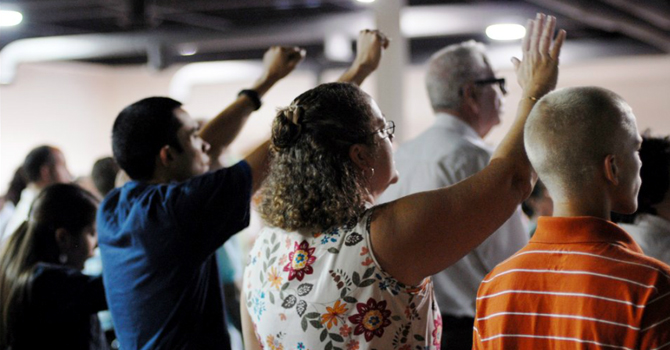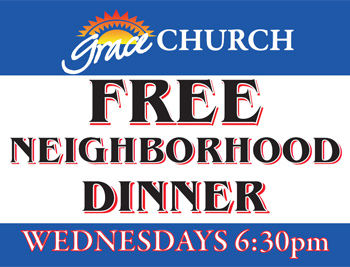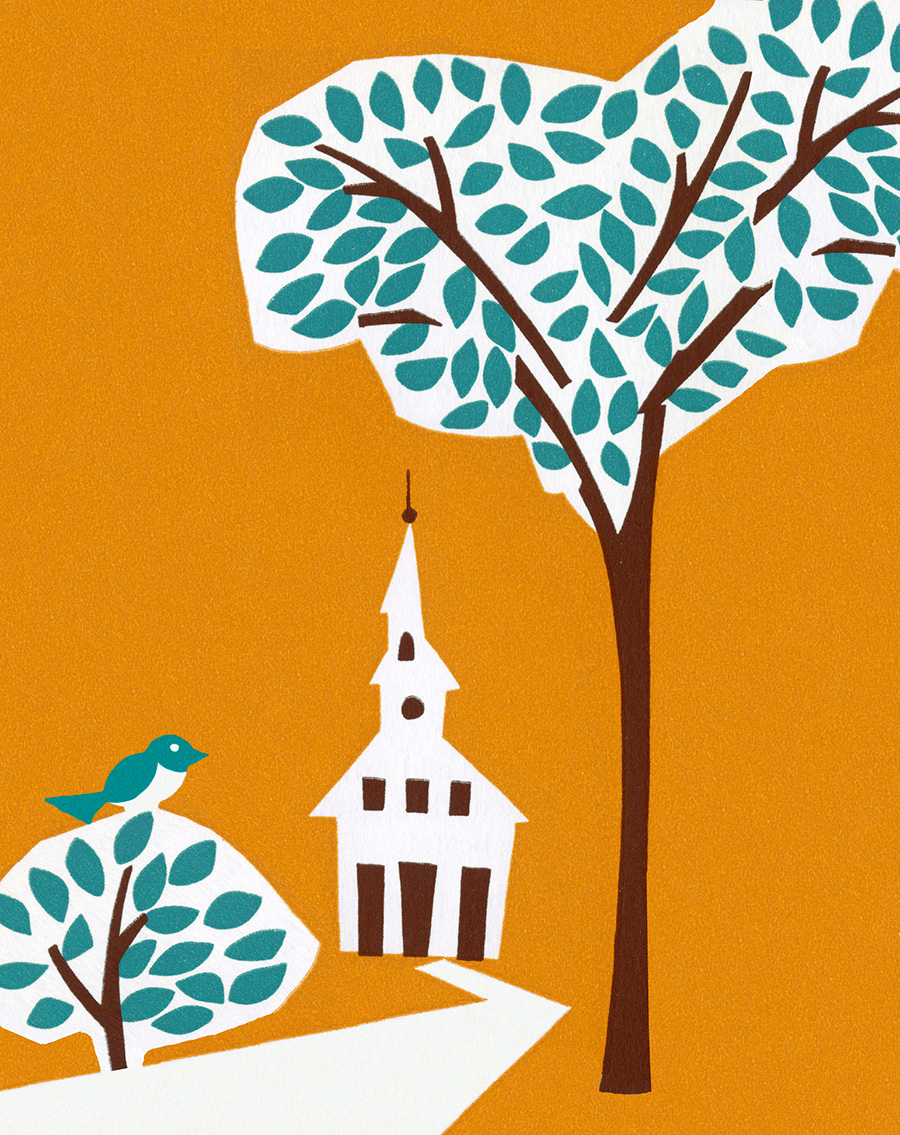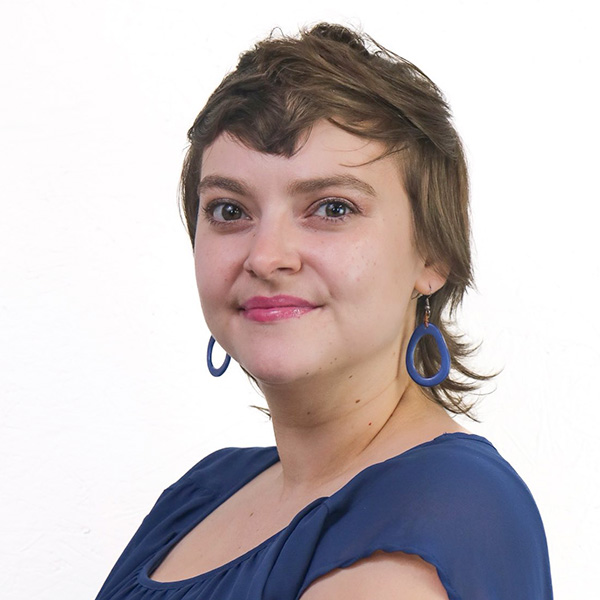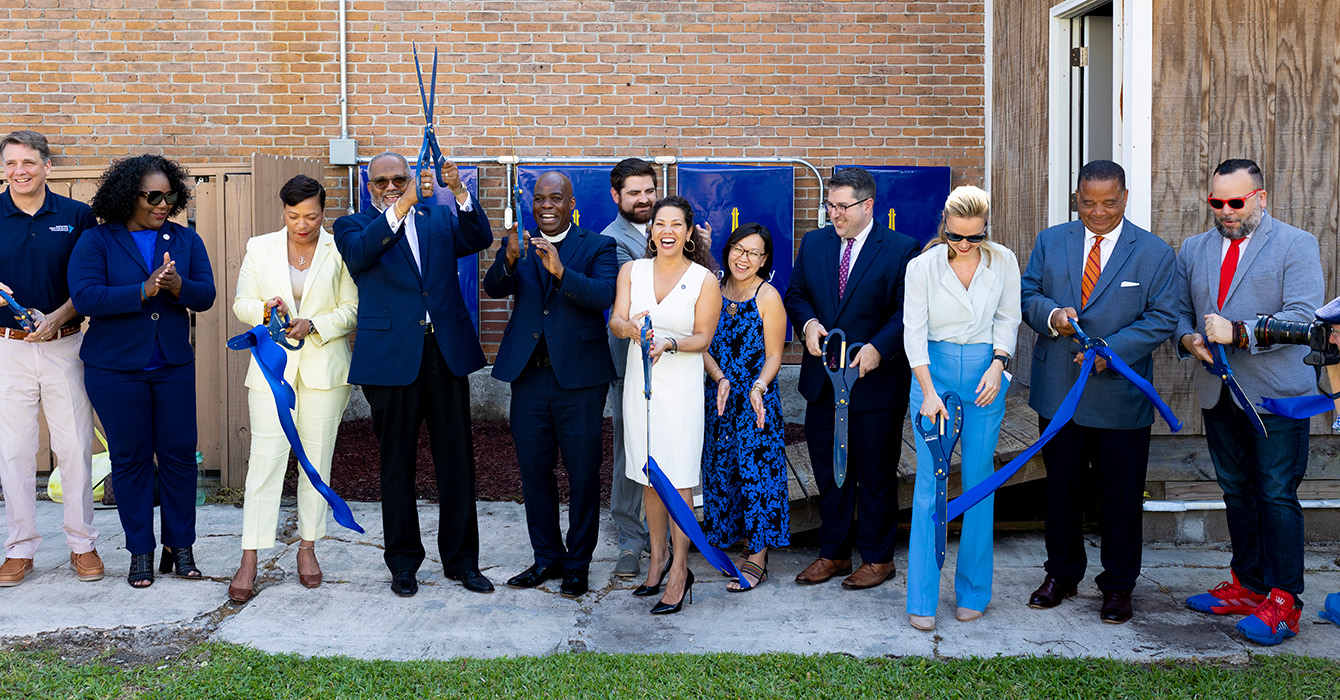The line began forming before 5:30 a.m., long before the late-November sun rises in south Florida. By 8:30, when the doors opened, it stretched the length of the former Winn-Dixie, around the corner and across the front.
The 250 who were waiting -- and the hundred or so who followed -- came to Grace Community Center in Cape Coral that Saturday for help, and over the next few hours they got it. After a brief worship service, 100 volunteers from throughout Grace Church gave out food and clothes, performed blood pressure checks and other health screens, made referrals for food stamps, housing and other services, and even cut hair.
They -- the volunteers -- were middle-aged women in tracksuits, tattooed bikers, retirees in Hawaiian shirts, recovering alcoholics, uniformed Boy Scouts and at least one ponytailed former drug dealer. Caught in a bad economy, the people in line weren’t much different. More than a few were also Grace Church members. At this event, which happens the third Saturday of every month, Grace can be found on both sides of the table.
“We’re a megachurch that doesn’t look like a megachurch,” said the Rev. Jorge Acevedo, lead pastor, as he watched the morning’s work. “We’re making a community out of rednecks and Latinos and African-Americans.”
Grace is indeed a rare church, said Warren Bird, a sociologist of religion and director of research for Leadership Network. It is a mostly working-class, mainline, multi-site megachurch with a passion for community service, a church that intentionally seeks “the people nobody else wants or sees.” And it is growing.
“None of those elements by themselves are unique,” said Bird, who studied Grace in depth as part of a 2008 survey of megachurch attenders. “But when you add all those pieces together, what’s happening at Grace is highly unusual.”
Church boom, bust and boom again
Founded in 1978, as Cape Coral was booming, Grace United Methodist Church thrived for a dozen years before declining in the early 1990s. By the time Acevedo was appointed in 1996, only about 400 people attended Sunday worship, down from 1,000 a few years before.
Today, Grace Church draws more than 2,800 people a week to nine Sunday services and other worship gatherings across four campuses. Two of those campuses are adoptees -- struggling United Methodist churches that Grace brought into its family and turned around.
- Grace Cape Coral is the original Grace Church, what some call “the mother ship,” with a weekly attendance of about 1,400 at three Sunday services and more than 400 at recovery meetings on Friday.
- Grace Fort Myers Shores, formerly Olga-Fort Myers Shores UMC, is located 17 miles away. Adopted in 2004, the church draws more than 300 people a week to three Sunday services, up from about 50 before the merger.
- Grace Community Center is six blocks from Grace Cape Coral in a converted Winn-Dixie the church bought in 2007 and opened one year later. In addition to the Third Saturday event, the center houses numerous outreach ministries, including a thrift store, a food bank, parenting and GED classes, an afternoon program for at-risk youth and a Sunday worship service that draws more than 300 people.
- Grace Central, formerly Central UMC, is six miles from the Cape Coral campus in a racially mixed, low-income neighborhood near downtown Fort Myers. Central joined with Grace in August 2010 after a year’s discernment and has already seen Sunday attendance jump from about 30 to about 130.
Booming numbers, however, aren’t the only thing that separates Grace from most UMC or other mainline congregations.
To some, Grace may not look or act like a United Methodist church. As Acevedo readily admits, the church is an amalgam of influences and is decidedly evangelical and spirited in tone. Each of the three church campuses still has a traditional worship service, but those mostly draw older adults and have the lowest attendance at each campus.
Most services -- six of the nine -- are contemporary and are highly spirited and emotional, with praise bands and altar calls. Worship can be ugly and messy, but it is somehow appealing, Acevedo said.
A graduate of Asbury College and Asbury Theological Seminary, Acevedo cites many influences on his ministry, including orthodox biblical Christianity, Bill Hybels of Willow Creek and Rick Warren of Saddleback Church. But at its core, he said, Grace is arguably more Methodist than many UMC congregations, because it is deeply Wesleyan, emphasizing both personal piety and social outreach. Acevedo should know. His UMC credentials are impressive. He was the UMC “distinguished evangelist” for 2009 and a steering committee member of Call to Action, an effort to reform the denomination.
Grace’s vision, set out in a 24-page “playbook” that guides the four campuses, is “to partner with God in transforming people from unbelievers to fully devoted disciples of Jesus to the glory of God.” Like Wesley, Grace Church is passionate not only about evangelism but also about growing people into discipleship, Acevedo said. The church’s strategy is expressed in four words that seek to summarize a Wesleyan vision of sanctification -- reach, connect, form, send.
“We want to reach people, welcoming them with the radical welcome of God,” Acevedo said. “We want to connect them to the family of God in relationships. We want to help form them into Christ’s likeness, and we want to send them out as missionaries.”
It is this profoundly Wesleyan approach, reaching out to working-class folks and people in need, that is Grace’s greatest strength, said the Rev. Timothy Whitaker, bishop of the Florida Annual Conference. An enthusiastic supporter of Grace, Whitaker noted that Methodism began as a powerful movement among poor working people but over time became part of the “respectable” middle class.
“What’s positive about Grace Church is that it’s effective at reaching the kind of people that Methodists used to reach routinely but that we do not reach very well anymore,” Whitaker said. “I’m talking about people who are in the working class or people who are struggling with financial and other issues.”
Grace probably isn’t a model that can be set down in just any community, Whitaker said. Its evangelical tone and spirit might leave some mainliners uncomfortable, but it works for Grace Church and the people it is trying to reach, he said.
“There are a lot of people like that in Cape Coral-Fort Myers, so this makes the style of Grace Church culturally relevant there,” Whitaker said.
No shortage of hurt
There is no shortage of hurt in the area. Ground zero of the mortgage crisis, Cape Coral-Fort Myers in 2009 had one of the nation’s highest foreclosure rates, with 11.9 percent of homes in foreclosure, second only to Las Vegas’ 12 percent. In October 2010 alone, 1 in 97 homes in Lee County received foreclosure filings. Unemployment hovered around 13 percent for most of 2010, far above the national average of 9 percent.
Kevin P. Sheahan is among those hurting. Once the owner of his own construction firm, he moved to Florida at the height of the construction boom to work in management for a roofing company. When the mortgage crisis erupted, construction -- the area’s largest source of employment -- stopped.
“Everything crashed,” Sheahan said. “I’ve been unemployed two years.”
In 2010, Sheahan took classes to become certified in animal massage and pet care (“I’ve massaged animals you didn’t even know existed,” he said). He’s started his own firm, KP Pet Kare, and believes there is a market for his services among the area’s many pet-owning retirees.
“I have to find some way to make a living,” he said.
Sheahan came to Grace through one of the church’s widest and most welcoming portals: Celebrate Recovery. An explicitly Christian 12-step program, Celebrate Recovery was founded in 1991 at Saddleback Church and is now in use at more than 10,000 churches around the world. The program provides support for people recovering from a variety of addictions, from alcohol and drug dependency to food and sex.
About 800 people participate in Celebrate Recovery at Grace, attending weekly meetings that include dinner, worship, small-group sessions and a coffeehouse. Acevedo estimates that a third of those who worship at Grace came into the church through Celebrate Recovery. Grace’s program, Acevedo said, is one of the nation’s largest, rivaling those at much bigger churches, including Saddleback.
Inevitably, Celebrate Recovery has had a huge impact on life and ministry at Grace, said the Rev. Wes Olds, campus pastor at Cape Coral.
“It creates this honest authentic culture,” he said. “People are drawn to real authentic communities where they can get well.” And because discipleship is recovery from sin, everybody needs recovery, Olds said.
The program flavors everything from worship to community outreach. At least some of the informality at Grace is to accommodate the needs of those still struggling with addictions. It’s OK to drink coffee. A smoking area is just outside the door.
A lot less threatening than church
At the Community Center, it’s even easier to “go to church.” Several feet from the worship area, cafe tables and chairs are set up around the perimeter of the room. It’s a space where people can observe, perhaps even experience, church without feeling like they’re “in church,” said Chris Jackson, the center’s director.
“This is a lot less threatening,” Jackson said. “The tables give people a good place to ‘watch’ church without taking a seat in the worship area.”
Over weeks and months, however, many “watchers” move into the worship area and eventually into the full life of the church.
Once people are in, Grace expects a lot from them. Because service to others is an essential part of recovery, Celebrate Recovery participants are among the church’s most dedicated volunteers, Acevedo said. Many volunteers at the Third Saturday event in November had attended Celebrate Recovery the night before at the Cape Coral campus.
But if a third of Grace people came to the church through recovery, two-thirds did not. Yet Grace has a rare ability to integrate them all into one community, Bird said. Acevedo -- a self-described “alcoholic and drug addict in recovery” -- champions the notion that everyone is broken and needs recovery and that all are welcome. As a result, integration occurs naturally.
“It’s reached such a critical mass at Grace that it’s not an issue anymore,” Bird said. “It’s like ethnicity when a church tries to become more multiethnic. By the time you’re at 20 or 30 percent ethnic, it’s a nonissue and doesn’t have to be defended or explained.”
Going multi-site
In its effort to reach “the people nobody else wants or sees,” Grace in recent years has turned to a new form of evangelism, one of the biggest trends in American Protestantism today: the multi-site church movement.
Multi-site churches -- churches that hold services in more than one location -- are increasingly common, with about 3,000 multi-site churches in 47 states, Bird said. Almost all of those -- 99 percent -- became multi-site only in the past 10 years. In a survey of multi-site churches for Leadership Network, Bird found that churches became multi-site to reach areas and people that were otherwise unreachable from their primary locations. (Read more about Bird’s research.)
Acevedo said Grace entered multi-site ministry not by any plan but “by the nudging of the Holy Spirit -- or, in more earthly terms, by accident.” In 2003, he was driving by Fort Myers Shores UMC when he “felt a nudge to do something.” He knew the church was headed for closure but thought the congregation and the surrounding area had great potential. He approached his bishop and district superintendent about the possibility of adopting Fort Myers Shores, and a few months later, agreement was reached to merge the congregations.
Acevedo didn’t know it, but he was at the beginning wave of the multi-site movement. Not only were churches nationwide beginning to expand to additional campuses; many were doing as he proposed -- merging with or adopting existing congregations. About a third of multi-sites added a campus by merging with an existing congregation, Bird’s research shows.
As part of the transition, Grace sent about 25 members to Fort Myers Shores to attend for at least two years.
In 2008, Grace added its third campus with the opening of the Community Center. It was intended as a place to house Grace’s growing outreach ministries and also serve as an annex for the main Cape Coral campus, providing worship space on Sundays and easing crowding at the main campus.
It was with the fourth addition, the Central campus in Fort Myers, that Grace made a more deliberate decision to pursue a multi-site strategy, Acevedo said.
“At Fort Myers Shores, we didn’t have a clear understanding of leadership and what that would look like in a multi-site setting,” he said. “So we made a lot of mistakes that we didn’t make with campuses three and four, like having policies, understanding clear lines of relationship, and communication and accountability.”
Acevedo said he and the campus pastors strive to keep people connected to the broader Grace Church. Each campus has its own guide team of laity and staff that oversees the campus and its ministries, while the overall direction of Grace Church comes from the Grace Leadership Council, led by Acevedo, with lay and staff representatives from each campus.
As lead pastor, Acevedo says his most important function is to serve as a “cultural watchdog,” holding everyone to account and “barking” when the church strays from its core mission.
“I function more like what a presiding elder did in the Wesleyan movement, which is constantly learning, coaching, leading, admonishing and encouraging the campus pastors,” he said.
He and other church leaders, lay and clergy, hold each other accountable every week, using a form with a series of questions in two broad areas: (1) How is it with your soul? Are you abiding with Jesus? and (2) How is it with your ministry? Are you abounding for Jesus?
Sermons are written collaboratively, with broad themes and texts selected for a six-month period. The campus pastors and Acevedo meet weekly to discuss the upcoming sermon and together devise an outline and contribute illustrations and anecdotes. From that, Acevedo writes a draft, which each pastor adapts to fit his or her own preaching style and campus.
Church might look a little different at each campus, but all the sites are connected by a common vision, mission and strategy, Acevedo said.
“It’s like McDonald’s at SeaWorld has a Shamu theme and McDonald’s at Disney World has a Mickey Mouse theme,” Acevedo said. “But the reality is that they all serve Big Macs, fries and shakes. We’re real clear about our Big Macs, fries and shakes. That’s what connects us.”
Questions to consider
Questions to consider:
- What are the great needs of your community? To whom and for what are you listening? How are you responding?
- At Grace, the lines blur between those who help and those who are helped. Where do you experience those blurred lines, and what difference do they make?
- The campuses at Grace have a common vision and strategy, and each week the pastors work together to craft the sermon and hold each other accountable. What are your weekly practices that deepen the corporate vision and strategy and your vocation? With whom do you engage these practices?
- What conditions are needed for congregations to cooperate closely? How are those conditions nurtured?

